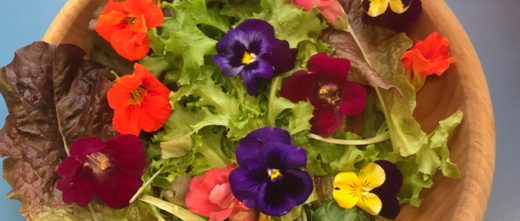The Local newsletter is your free, daily guide to life in Colorado. For locals, by locals.
If you follow as many food-focused Instagram accounts as we do, you’ve probably noticed an emerging trend: edible flowers. They’re cropping up as accents on dishes both savory and sweet, but they’re not just for professional chefs and food stylists. As it turns out, edible flowers are actually an incredibly easy way to add bold color and subtle flavor to what you’re cooking at home.
We asked Arcana’s executive chef Kyle Mendenhall why he chooses to incorporate so many blooms in his dishes. For him, it’s just another component of the Boulder restaurant’s root-to-stalk style of cooking. Exhibit A: an inky fermented black garlic and “troutchovy” (salty house-cured trout) dip. Mendenhall accents the dish with purple chive flowers and serves it with crunchy Salanova lettuce roots—which Boulder’s Toohey & Sons Organic farm would have otherwise mulched or composted—for dipping. While Mendenhall certainly appreciates the color that the blossoms add, he notes that using flowers “kills two birds with one stone,” as they have a more delicate flavor than the mature plant and they disperse easily throughout a dish without the need for chopping. His kitchen makes widespread use of herb flowers such as chives, garlic chives, and sage, which currently add a pleasant burst of purple to a pork dish. Last year, Mendenhall even featured sunflower hearts on the menu—he likens them to artichoke hearts—which were garnished with nutty edible sunflower petals. Who knew?


And while Mendenhall gets the majority of his edible flowers directly from farmers (or, in the case of those sage blooms, from his sous chef’s garden), home cooks in Colorado can look to Osage Gardens’ products. For 25 years, the New Castle farm has been supplying Colorado grocery stores with a year-round crop of immaculate culinary herbs and spectacular edible flowers. Owners Sarah and Tom Rumery originally began packaging the blooms—a mix of nasturtiums, rose petals, pansies, snapdragons, borage, and sweet pea—alongside their herbs to add an eye-catching pop of color amidst the shades of green. “On tours, we always take folks by the flower patch and encourage them to try a nasturtium flower. They’re always surprised at how delicious they are,” Tom says.
Sarah has a few easy-to-execute starter ideas for using edible flowers at home: make a simple appetizer by topping a cracker with a swipe of cream cheese and a peppery, bright nasturtium flower; freeze the blooms with water or wine in ice cube molds for gorgeous summer drinks; or, easier still, toss the flowers into your salad mix and proceed as usual. Bonus: Osage Gardens is certified organic, so no need to worry about pesticide contamination.
You can find Osage Garden’s edible flowers at Whole Foods Market and Natural Grocers locations across the Rocky Mountain region. Farmers’ markets are also a good place to start searching for edible blooms to incorporate into your home cooking. Better yet, consider growing them yourself—nasturtiums make fabulous additions to any Colorado garden and are incredibly easy to grow from seed.








